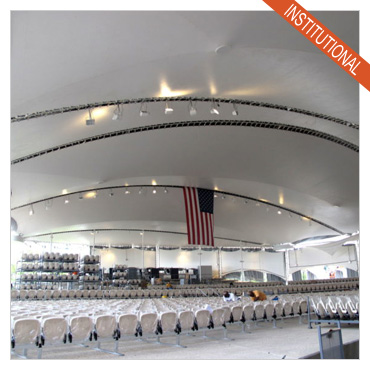|
BRIEFLY… |
|
|
|
|
|
Sponsored
|
|
|
|
Sponsored
|
|
|
|
|
|
FORM + FUNCTION |
 |
In June, a 5000-seat concert venue joined the attractions of Coney Island in Brooklyn, New York, as part of Riegelmann Boardwalk’s new Seaside Park and Community Arts Center. The Ford Amphitheater, a $53-million project, relied in part on its eyecatching roofing to achieve project goals. The project was completed thanks to the work of a variety of contributors, including tensile roofing consultant FTL Design & Engineering Studio and general contractor Hunter Roberts Construction Group. The design and installation of the amphitheater’s fabric roof was completed by its manufacturer, while WSP USA and Mueser Rutledge Consulting Engineers were responsible for geotechnical engineering.
|
|
|
|
The January 2017 issue of The Construction Specifier included an in-depth look at the world of hygienic ceilings. Now, this complementing web feature enables the authors to examine various regulations and guidelines for designing and maintaining ceilings in hospitals, food preparation areas, labs, schools, and other facilities with hygienic requirements.
|
|
EVENTS
January 18-20
The International Surface Event
Informa
Las Vegas, Nevada
tisewest.com
January 28-February 1
ASHRAE Conference/AHR Expo
American Society of Heating, Refrigerating, and Air-conditioning Engineers
Las Vegas, Nevada
www.ashrae.org
January 29-February 1
Sprayfoam 2017 Convention & Expo
Spray Polyurethane Foam Alliance (SPFA)
Palm Springs, California
www.sprayfoam.org/expo
February 12-15
AAMA 80th Annual Conference
American Architectural Manufacturers Association
Phoenix, Arizona
www.aamanet.org/events
March 16-21
RCI International Convention and Trade Show
RCI
Anaheim, California
rci-online.org
April 4-7
Coverings
Tile of Spain/Ceramics of Italy/TCNA
Orlando, Florida
www.coverings.com
May 24-28
CSC National Conference
Construction Specifications Canada
Kelowna, British Columbia
csc-dcc.ca/Conferences
|
|
|
VIEW LATEST ISSUE

|
|
TOP TRENDING ARTICLES |
The cost of heating a building is a major expense for most building owners, and it is also a cost to the health and well-being of the general population in carbon pollution. By incorporating renewable energy technologies into the design and construction of a building, both these costs can be substantially reduced. Building owners are seeking ways in which to reduce their energy consumption. According to the U.S. Environmental Protection Agency (EPA), the country’s buildings account for 36 percent of total energy use, and 30 percent of greenhouse gas (GHG) emissions. Renewable energy technologies offer several methods in which to reduce both energy consumption and emissions. One example is a transpired solar collector—an air-preheating system that augments the building’s standard heating system.
|
When it comes to designing indoor swimming pool facilities, it is critical to ensure not only a healthy interior environment, but also energy efficiency. New technologies can both provide optimal natatorium environmental control and curtail utility consumption when specified. Commercial dehumidifiers and 100 percent outside air ventilation system (OAVS) technology for indoor pools have significantly changed in the last decade. Consequently, a new or retrofitted natatorium HVAC system can potentially save millions of dollars in energy costs over the equipment’s 15 to 25-year life cycle, depending on the sustainable options specified.
 READ MORE READ MORE
|
Over the last decade, exterior shading has become more popular in the U.S. construction market. However, many architects and building owners still have limited knowledge about these systems and why they should be considered part of the building design. This article explores 10 frequently asked questions about exterior shading, while providing insight into available systems and how they can be an important part of the building’s environmental control.
|
|
|
|
|
|

